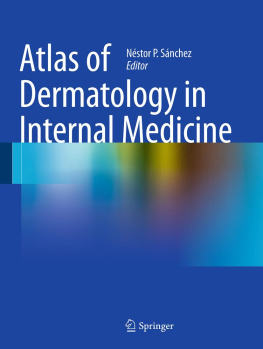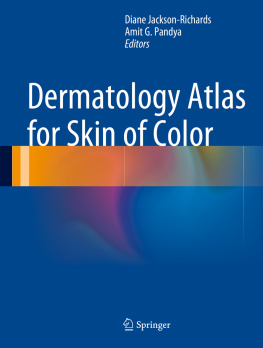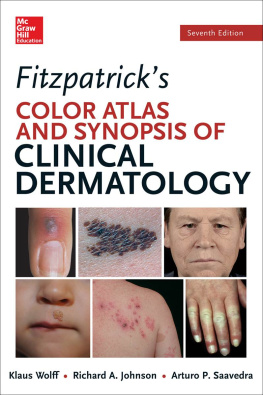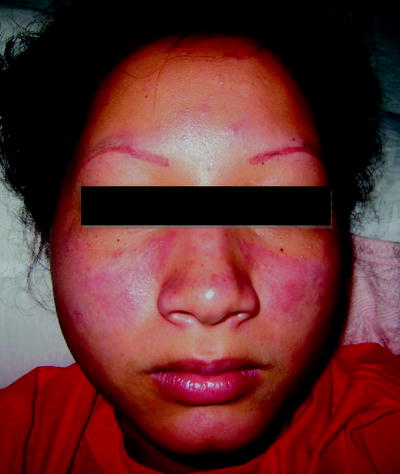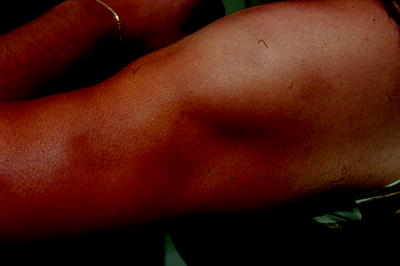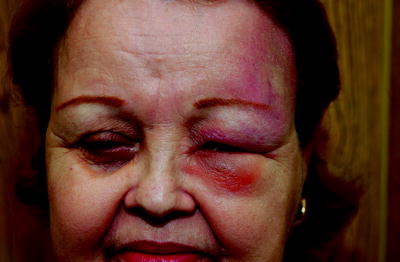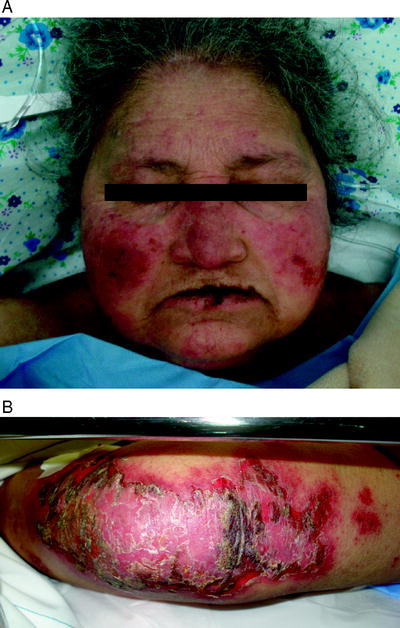Systemic lupus erythematosus (SLE) is an autoimmune inflammatory disease, which can affect multiple organ systems, including the skin []. These will each be discussed in detail in the remainder of the chapter.
Acute Cutaneous Lupus Erythematosus
Malar erythema is commonly the first manifestation of SLE, and the most common manifestation of acute cutaneous lupus erythematosus (ACLE). It can precede other systemic manifestations of SLE by weeks or months, and frequently coincides with disease exacerbations. The rash is characterized by erythema, edema, and occasionally fine scales in a malar distribution, along the bridge of the nose, with characteristic sparing of the nasolabial folds (Fig. ].
Fig. 1
Acute cutaneous lupus erythematosus associated with systemic lupus erythematosus
Subacute Cutaneous Lupus Erythematosus
Subacute cutaneous lupus erythematosus (SCLE) is a distinctive subset of lupus erythematosus. Patients can develop cutaneous lesions with two different morphologies: papulosquamous and annular, polycyclic lesions. There is no induration or telangiectasias. The distribution of the lesions is generally on sun-exposed areas, particularly the dorsal surface of upper extremities, upper back, and chest [].
Histopathologically, the lesions are very similar to those of discoid lupus erythematosus (DLE); however, SCLE lesions have minimal hyperkeratosis and follicular plugging. Instead, they are characterized by more prominent epidermal atrophy and liquefaction degeneration of the basal cell layer. The inflammatory infiltrate in contradistinction to DLE tends to be scattered throughout the reticular dermis, but similar to DLE, is composed of activated T-cells [].
Chronic Cutaneous Lupus Erythematosus
The wide spectrum of CCLE includes the classical discoid lesions that can be localized or generalized, chilblain, hypertrophic, verrucous, lichenoid, lupus panniculitis (profundus), mucosal discoid, palmoplantar erosive, or lupus erythematosus tumidus lesions []. We will discuss the most commonly seen.
The lesions of DLE are characterized by well-defined, disk-shaped, erythematous plaques with epidermal atrophy, telangiectasias, and scaling (Fig. ].
Fig. 2
( a , b ) Discoid lesions of lupus erythematosus (chronic cutaneous lupus erythematosus)
Hypertrophic DLE is a distinct form of DLE, which is characterized by hyperkeratotic plaques that typically are observed over the face, extensor surfaces of the arms, legs, and upper trunk [].
Lupus panniculitis (also known as lupus profundus) is a condition characterized by multiple firm, well-demarcated subcutaneous nodules or plaques that are persistent and painless (Fig. ].
Fig. 3
Lupus panniculitis (lupus profundus): Well-demarcated depressed plaques with atrophy located on the upper extremity of a patient with lupus panniculitis
Chilblain lupus is a rare manifestation of CCLE consisting of lesions induced by cold in acral areas. They are pruritic or painful and can have erythematous papules that ulcerate or become hyperkeratotic [].
Lupus erythematosus tumidus is characterized by marked photosensitivity and a tendency to occur in the male sex (Fig. ].
Fig. 4
Lupus erythematosus tumidus. Succulent, erythematous plaque involving left upper forehead
The differential diagnosis of cutaneous lupus erythematosus includes sunburn, rosacea, seborrheic dermatitis, allergic contact dermatitis, phototoxic drug eruption, polymorphous light eruption, tinea faciei, granuloma faciale, sarcoidosis, alopecia mucinosa, and benign lymphocytic infiltrate of Jessner [].
Bullous Systemic Lupus Erythematosus
The bullous lesions of lupus erythematosus are predominantly located on the face, neck, and upper trunk. They tend to be tense and may rupture leaving erosions, crusts, and changes in pigmentation (Fig. ].
Fig. 5
( a , b ) Exacerbation of systemic lupus erythematosus presenting clinically with bullaes and erosions in skin and mucous membranes. Blistering usually indicate a more severe systemic disease

